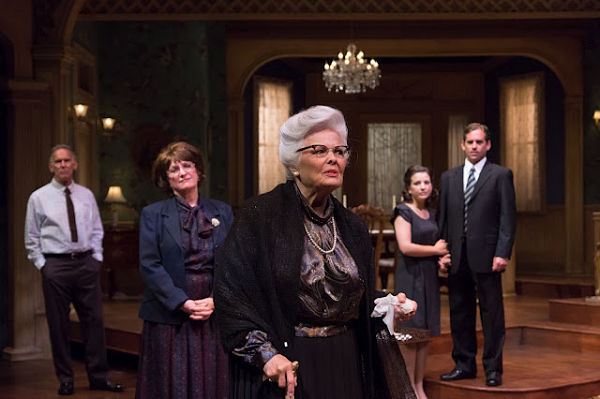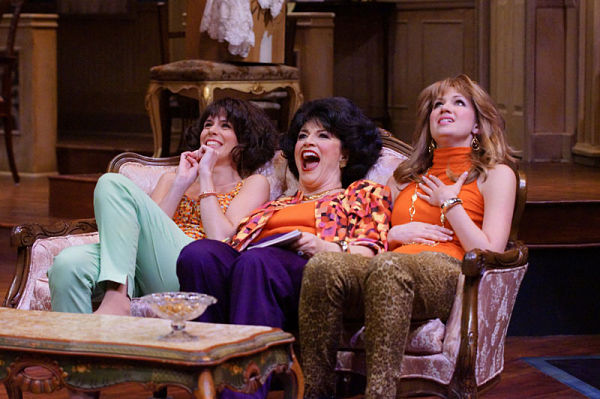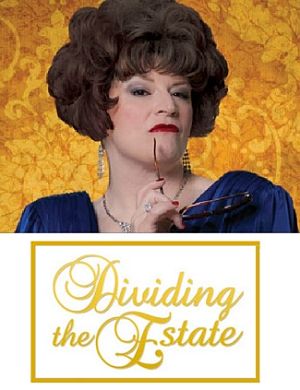Review: Dividing the Estate by Zach Theatre
by David Glen Robinson
The Zach Theatre is a great showcase for local and regional art and talent, claiming as it does all the advantages of location, etc. It seems to hold court over Lady Bird Lake, with hill country scenery upstream and the shining, multi-colored towers of Austin across the lake. I visited Zach to see Dividing the Estate, Horton Foote’s 1989 play about a Texas family falling apart over estate inheritance.
To cut to the chase, the family had already fallen apart, and so had the estate of the title, which was really only a metaphor for that family. The former glory of the estate was represented by the gorgeous set by Cliff Simon. If you think this is a spoiler and with that the play was over save for upscale furniture-gnawing, think again, for this was indeed only the beginning. Dividing the Estate is a brilliant exposition of time and place and how the fortunes of families and individuals depend on those elemental things. The Zach Scott production of the play does it proud.
The time of the play is the mid-eighties oil bust, the one centered in Houston. The place is fictional Harrison, Texas. The real-life place is Wharton, Texas, without a doubt. The characters discuss the features and problems of life in Wharton, Texas in great, accurate detail. These include the vast acreages of grazing land tumbling in value, proximity to Houston (in every sense), sulfur domes, oil wells, ranching mansions, a main street lined with empty store fronts and a plastics plant run by Asian investors (still in operation today).

Why Wharton? Wharton is the birthplace of Horton Foote. Place is not always formative of one’s view of the human condition, but in Foote’s case, I think it was. He was born there but left to gain his college education far out of state. He returned to a residence there in the 1980s, according to Wikipedia, but did not stay there until the end of his life. Dividing the Estate is a fictionalized memoir of Foote’s return to Wharton in the 1980s.
The influence of Wharton on him struck me in an odd, accidental way. More than a year ago, I traveled to Wharton on other business and stopped in at the Wharton County History Museum (also mentioned in the play). There amid the history, industrial dioramas about sulfur domes and the gallery of stuffed animals (Wikipedia runs a picture of one of its lions and captions it “the tiger exhibit,” tee-hee) I came across a large display on Horton Foote, with pictures of his early life and a long display list of his plays, teleplays, screenplays and awards, including the Pulitzer Prize and two Academy Awards. My reaction after being stunned by it all was, “Horton Foote came from here?”
Wharton was settled as a pioneer town in the 1820s on the lush Texas coastal plain where the coastal grass grew higher than the giant Zebu cattle imported from India to eat it. By the late nineteenth century there were several times more cattle than human beings resident in Wharton County. A story I have heard, which may be apocryphal, is that Wharton passed a city ordinance stating that the main street and courthouse square merchants bore the responsibility for removing cattle dung from the streets and sidewalks. At that time, the agrarian populations viewed their work as fulfilling the potential of the land, not degrading it, and this view was affirmed for them as the ranching families grew rich and then very rich. Add to this the Antebellum legacy of African-American freedmen who had nothing, labored hard over multiple generations, and still have nothing. Regardless of class and ethnicity, the people of Wharton also saw Overwhelming Nature with its withering droughts and angry, blow-down hurricanes. The Wild, that which they could not control, sowed in them seeds of uncertainty and humility in the face of it all. This is the milieu not only of Wharton but of all of pioneer America. Foote changed the name Wharton to Harrison no doubt to give the play’s insights a more universalizing effect, but he needn’t have bothered. In Dividing the Estate the uncertainty, not so much the humility, grew into the basis of fear from which some of the characters fought so viciously against their own families.

And so Dividing the Estate came into being, with a large cast of characters, each with pithy gems to bestow. And they did so generously. Powerhouse actors Janelle Buchanan, Barbara Chisholm and Joey Hood worked brilliantly and subtly to build an ensemble that gave every character full voice. The payoffs included clear expositions of subtle nuances of family life that all of us know in our own lives but which may be difficult to convey on stage. For example, here is a family that fights bitterly but then unselfconsciously joins in hymn-singing (In Heavenly Love Abiding), and later takes time out to share a round-robin belly laugh over a joke about everyone getting jobs at Whataburger to save the estate.

In what may be considered the climax of the play, the family servant, 92-year-old Doug, embodied and performed so very richly by Eugene Lee, gives a speech of crystalline memory about his family story. As lights from without come up on the exterior windows, building to an angry red as though at the approach of a huge, glowing monster that might be death, Doug tells of the bull that killed his father in a pasture, and how his penniless family was taken in by the Gordons and their estate, where they remain to this day. Doug’s monologue is one of those essential examples of Southern literature and storytelling. It is at once a distilled narrative, sermon and symbol; and it is decidedly Faulknerian. Its meanings are layered on at several levels, all in relatively few words. Everyone must see and hear this play.
OK, nothing’s perfect. There is a flaw in the play: Janis Stinson doesn’t get to sing even one song onstage. We’ll have to wait for Zach Scott’s next musical. But despite my light-hearted critique, the a capella singing by the cast is quite good and is a significant element of the sound design.
Horton Foote, the author of The Trip to Bountiful and Tender Mercies and many other works, created characters clearly etched by such Whartonesque experiences as those endured by the characters in Dividing the Estate. We can find in reading and hearing about these characters, even the rapscallions among them, a certain loving respect that Foote held for them coming through in the descriptions, thoughts and dialogues he wrote about them. Foote shared some of those etching experiences with them. This grants Foote’s characters a lived, experiential quality I do not always find in a lot of other modern playwrights. Foote gives humanity a break in his view of the human condition.
In 1987, Horton Foote was awarded an Honorary Doctorate of Humane Letters from Spalding University. Never was a degree more aptly named nor more propitiously awarded.
Review by Claire Canavan for the Austin Statesman's Austin360.com Seeing Things blog, June 4
Review by Olin Meadows at www.AustinOnStage.com, June 18
Review by Dan Solomon for the Austin Chronicle, June 21
Review by Margie Eades at NowPlayingAustin's blog, June 28
Hits s of 2015 03 01: 2100
Dividing the Estate
by Horton Foote
Zach Theatre
